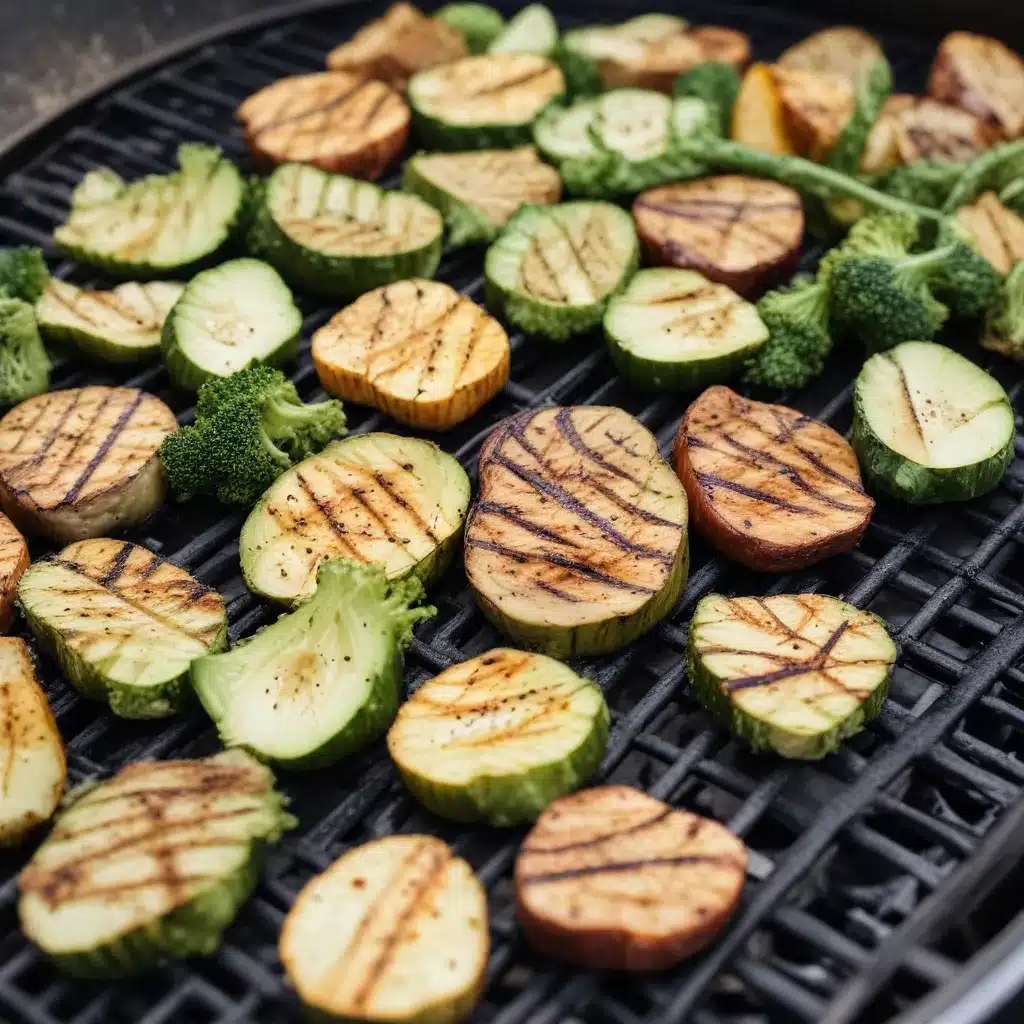
As an experienced barbecue pitmaster, I’ve honed my craft over the years, exploring the intricacies of grilling and smoking to unlock the full potential of every ingredient. One of the techniques I’m particularly passionate about is achieving the perfect sear on vegetables – that delightful caramelized crust that transforms even the humblest of produce into a flavor sensation.
Mastering the Sear: The Science Behind the Sizzle
The secret to an exceptional sear lies in understanding the science behind the process. When you expose vegetables to intense heat, the sugars and amino acids within the food undergo a series of chemical reactions known as the Maillard reaction. This phenomenon creates a complex array of new flavor compounds, resulting in that irresistible savory, nutty, and sometimes even slightly sweet taste we associate with grilled perfection.
To unlock this culinary magic, you need to create the right conditions on your grill or smoker. The key is to achieve a blazing-hot surface temperature, typically between 500-600°F (260-315°C). This level of heat quickly evaporates the moisture on the surface of the vegetables, allowing the Maillard reaction to take place.
Grill Setup and Equipment: Unlocking the Sear
Achieving the perfect sear requires the right grill setup and equipment. While you can certainly get great results with a traditional charcoal or gas grill, I’ve found that using a pellet grill like the ones from Creekside BBQ offers some distinct advantages.
Pellet grills excel at maintaining a consistent, high-heat environment, thanks to their precise temperature control and efficient airflow. By setting my Creekside pellet grill to its highest temperature setting and using the built-in “sear zone” feature, I can quickly create the intense heat needed to sear vegetables to perfection.
But it’s not just about the grill itself – the right accessories can also make a big difference. A cast-iron grill grate, for instance, retains heat exceptionally well, ensuring an even and intense sear across the entire surface. I’ve also had great success using a dedicated searing grate, like the one from Hurtado Smokebox, which creates a focused hot zone for maximum caramelization.
Preparing the Vegetables: Enhancing the Sear
Of course, proper preparation is key to achieving that elusive sear. I’ve found that a few simple techniques can make a world of difference:
-
Patting Dry: Thoroughly patting the vegetables dry with paper towels before grilling is crucial. Any excess moisture on the surface will inhibit the Maillard reaction and result in steaming rather than searing.
-
Oil and Seasoning: A light coating of high-heat-tolerant oil, such as avocado or grapeseed oil, helps facilitate the sear and ensures even browning. I also like to season the vegetables with a flavorful dry rub or salt and pepper to further enhance the caramelized crust.
-
Slicing and Cutting: The way you slice or cut the vegetables can also impact the sear. Thinner, more uniform pieces will sear more evenly, while thicker or irregularly shaped items may require some creative maneuvering on the grill.
Grilling Techniques: Maximizing the Sear
With the right setup and preparation, it’s time to put your grilling skills to the test. Here are some of my top techniques for achieving that perfect sear:
-
High Heat and Patience: As I mentioned earlier, high heat is essential for searing. But it’s also crucial to resist the temptation to move the vegetables around too much. Let them sizzle undisturbed for 2-3 minutes to allow the Maillard reaction to work its magic.
-
Rotate, Don’t Flip: Instead of flipping the vegetables repeatedly, try rotating them 90 degrees every minute or so. This helps ensure even browning all around without losing precious sear time.
-
Indirect Heat for Finishing: Once you’ve achieved that delectable sear, you can move the vegetables to a cooler zone of the grill or reduce the heat to finish cooking them through. This indirect heating method helps prevent the outside from burning while ensuring the interior is perfectly tender.
-
Baste and Glaze: For an extra layer of flavor, consider basting the seared vegetables with a flavorful sauce or glaze during the final stages of cooking. Just be sure to use a brush or tongs to avoid disrupting the sear.
Flavor Profiles: Unlocking the Potential
The beauty of grilling vegetables is the endless possibilities for flavor exploration. By experimenting with different seasonings, wood chips, and sauces, you can unlock a world of taste sensations.
For a classic barbecue twist, try seasoning your veggies with a spicy-sweet rub or coating them in a tangy, smoky barbecue sauce. The charred edges will complement the bold flavors beautifully.
Alternatively, you can take inspiration from global cuisines. A Mediterranean-inspired marinade of olive oil, garlic, and herbs can transform grilled zucchini or eggplant into a culinary delight. Or, for an Asian-influenced spin, try tossing your seared vegetables in a soy-ginger glaze or topping them with toasted sesame seeds.
The key is to let your creativity shine and find the flavor combinations that speak to your personal taste preferences.
Serving and Presentation: The Final Touch
Once your vegetables have reached that picture-perfect sear, it’s time to showcase your grilling prowess. Arrange the beautifully charred and caramelized pieces on a platter or plate, allowing their vibrant colors and enticing aromas to take center stage.
For an extra touch of flair, consider garnishing the dish with fresh herbs, a drizzle of high-quality olive oil, or a sprinkle of flaky sea salt. These simple additions can elevate the presentation and emphasize the natural flavors of the vegetables.
Remember, the true joy of grilling lies not just in the end result but in the entire experience. So, embrace the sizzle, savor the aroma, and revel in the satisfaction of mastering the art of the perfect sear. Happy grilling, my fellow barbecue enthusiasts!

